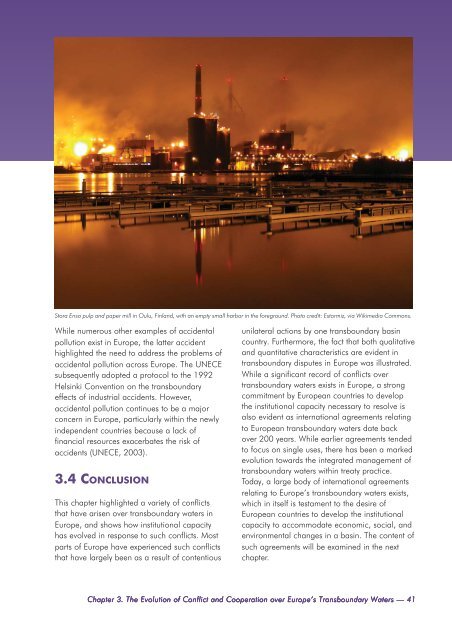Europe - UNEP
Europe - UNEP
Europe - UNEP
You also want an ePaper? Increase the reach of your titles
YUMPU automatically turns print PDFs into web optimized ePapers that Google loves.
Stora Enso pulp and paper mill in Oulu, Finland, with an empty small harbor in the foreground. Photo credit: Estormiz, via Wikimedia Commons.<br />
While numerous other examples of accidental<br />
pollution exist in <strong>Europe</strong>, the latter accident<br />
highlighted the need to address the problems of<br />
accidental pollution across <strong>Europe</strong>. The UNECE<br />
subsequently adopted a protocol to the 1992<br />
Helsinki Convention on the transboundary<br />
effects of industrial accidents. However,<br />
accidental pollution continues to be a major<br />
concern in <strong>Europe</strong>, particularly within the newly<br />
independent countries because a lack of<br />
financial resources exacerbates the risk of<br />
accidents (UNECE, 2003).<br />
3.4 CONCLUSION<br />
This chapter highlighted a variety of conflicts<br />
that have arisen over transboundary waters in<br />
<strong>Europe</strong>, and shows how institutional capacity<br />
has evolved in response to such conflicts. Most<br />
parts of <strong>Europe</strong> have experienced such conflicts<br />
that have largely been as a result of contentious<br />
unilateral actions by one transboundary basin<br />
country. Furthermore, the fact that both qualitative<br />
and quantitative characteristics are evident in<br />
transboundary disputes in <strong>Europe</strong> was illustrated.<br />
While a significant record of conflicts over<br />
transboundary waters exists in <strong>Europe</strong>, a strong<br />
commitment by <strong>Europe</strong>an countries to develop<br />
the institutional capacity necessary to resolve is<br />
also evident as international agreements relating<br />
to <strong>Europe</strong>an transboundary waters date back<br />
over 200 years. While earlier agreements tended<br />
to focus on single uses, there has been a marked<br />
evolution towards the integrated management of<br />
transboundary waters within treaty practice.<br />
Today, a large body of international agreements<br />
relating to <strong>Europe</strong>’s transboundary waters exists,<br />
which in itself is testament to the desire of<br />
<strong>Europe</strong>an countries to develop the institutional<br />
capacity to accommodate economic, social, and<br />
environmental changes in a basin. The content of<br />
such agreements will be examined in the next<br />
chapter.<br />
Chapter 3. The Evolution of Conflict and Cooperation over <strong>Europe</strong>’s Transboundary Waters — 41
















